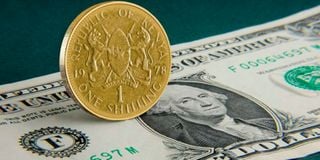Premium
Kenya shilling tipped to weaken further on low forex inflows

Kenya’s overall balance of payments has fluctuated over the years to stand at a Sh127.8 billion deficit in the first quarter of this year.
What you need to know:
- The Kenyan unit was exchanging at Sh147.26 against the greenback on Thursday, according to data from the Central Bank of Kenya (CBK), compared to Sh120.45 during the same period last year marking a depreciation of 22.2 percent.
Lower foreign exchange inflows and higher global interest rates are the key factors that will see the Kenyan shilling continue to lose ground against the US dollar, according to data analytics and intelligence firm Stears.
The Kenyan unit was exchanging at Sh147.26 against the greenback on Thursday, according to data from the Central Bank of Kenya (CBK), compared to Sh120.45 during the same period last year marking a depreciation of 22.2 percent.
Kenya relies on forex inflows from diaspora remittances, exports, tourism, foreign direct investment and foreign loan disbursements to stabilise the currency.
The US Federal Reserve has, however, been raising rates, which has precipitated a flight of dollars from developing markets such as Kenya thereby weakening the currencies of those markets.
Stears has projected lower forex inflows and global rates to keep rising which will accelerate the depreciation of the shilling, which may lead to increased import costs and higher debt servicing expenses for dollar-denominated loans
“The Kenyan shilling is expected to trade within the range of Sh146 to Sh152 per US dollar in the coming weeks,” said the firm in an analysis as part of its recently launched Africa FX Monitor.
The intelligence tool provides daily FX updates on Africa's top economies, such as Nigeria, Kenya, and South Africa. It also includes insights on daily FX (foreign exchange) drivers.
"The confluence of lower forex inflows and the US Fed's tightening monetary policy has put significant pressure on the Kenyan Shilling,” said Dumebi Oluwole, a senior economist at Stears.
“These challenges highlight the need for businesses and investors to closely monitor the currency's performance and adapt their strategies accordingly.”
Kenya is a net importer of goods, and the weak shilling has seen the cost of imports shoot as well as the ballooning of the country’s foreign currency-denominated external loans.




